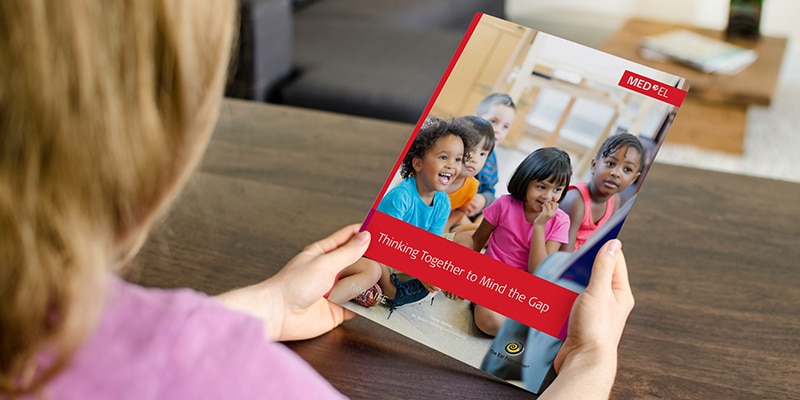MED-EL
Published Aug 28, 2020
Children with Hearing Loss and Theory of Mind Development

Keeping secrets. Sharing a joke. Playing make-believe. What do all of these behaviors have in common? Theory of Mind. Theory of Mind (ToM) is the ability to share another person’s perspective. When children have a fully developed ToM, they can judge what others think, feel or believe and act accordingly.
Although it was first identified as a challenge for children with autism, children with hearing loss also struggle to develop ToM.1,2,3 Typically hearing children usually master ToM between the ages of 4 and 5. However, children with hearing loss typically acquire ToM skills approximately 4 years later than their typically hearing peers.4
What is Theory of Mind?
ToM forms a basis for all social interaction and involves many different skills. It helps us understand and predict others’ behavior. Being able to recognize how other people feel and guess what they might be thinking is a key ingredient for connecting with others and developing friendships. Complex social situations require us to understand that what communication partners are saying may be different from what they are thinking and feeling. Communication requires us to use social cognition skills to understand the subtleties of social interactions to keep communicative relations successful and respond appropriately. This set of perspective-taking skills is known as ToM.
Why Is Theory of Mind Important?
ToM is the foundation of a child’s language acquisition and the development of appropriate social behavior and skills. Such skills are important because they facilitate communication and social interaction with peers and support the development of pragmatic language skills.5 Research shows that a developed ToM is crucial for healthy social relationships, such as making and keeping friends.
ToM is also important for academic success at school and is critical for literacy and academic achievements. Delayed ToM development has significant academic consequences, especially in accessing higher levels of literacy which require a high level of pragmatic comprehension and ToM abilities.1 Furthermore, Pelletier and Astington indicate a link between ToM skills and understanding narratives.6
Development of Theory of Mind
The understanding that people don’t share the same thoughts and feelings develops during childhood. This ability to tune into others develops in a predictable, developmental order. Babies demonstrate an early-developing intuitive awareness that forms the precursor to ToM. Similar to speech and language acquisition, ToM is a set of skills that needs many opportunities in different contexts to develop and flourish. This cognitive ability develops from infancy throughout childhood and adolescence on into adulthood7,8. The stages of ToM development are described in detail in Thinking Together to Mind the Gap.
Theory of Mind and Children With Hearing Loss
Research suggests that children with hearing loss have difficulties developing ToM skills1,2,3, which impacts how they behave socially and engage academically. Late access to hearing technology, language delays, less exposure to vocabulary about emotions and thinking, and less exposure to overhearing conversations about mental state language may create a challenge in developing ToM skills.
Like young typically hearing children, children with hearing loss develop ToM skills by hearing and seeing them naturally modeled through play, conversations, and everyday routines. However, some children with hearing loss still have a significant delay in ToM skills as they start school or that becomes obvious as they move to upper primary. For these children, the variety of skills involved in ToM may need to be more explicitly taught.
For more information on all of the abovementioned points see Thinking Together to Mind the Gap. This is a free resource for rehabilitation professionals, written to shine a light on ToM skills, development and explain how ToM is related to listening and language. It also shares ways therapists can use the MED-EL Lesson Kits and Murat Reader Series to create fun and engaging activities to promote ToM skills in preschool and school-age children.
Download Thinking Together to Mind the Gap now.
- Morgan, G. (2015). Social-cognition for learning as a deaf student. Educating deaf learners: Creating a global evidence base, 261-282.
- Schick, B., De Villiers, P., De Villiers, J. and Hoffmeister, R. (2007). Language and theory of mind: A study of deaf children, Child development, 78(2), 376-396.
- Moeller, M.P. & Schick, B. (2006). Relations between maternal input and theory of mind understanding in deaf children. Child development, 77(3),.751-766.
- Goberis, D., Beams, D., Dalpes, M., Abrisch, A., Baca, R. & Yoshinaga-Itano, C. (2012). The missing link in language development of deaf and hard of hearing children: pragmatic language development. Seminars in speech and language, 33(4), 297-309.
- Russell, P.A., Hosie, J.A., Gray, C.D., Scott, C., Hunter, N., Banks, J.S. & Macaulay, M.C. (1998). The development of theory of mind in deaf children. The Journal of Child Psychology and Psychiatry and Allied Disciplines, 39(6), 903-910.
- Pelletier, J. & Astington, J. W. (2004). Action, consciousness and theory of mind: Children’s ability to coordinate story characters’ actions and thoughts. Early Education and Development, 15, 5-22.
- Alic, M (2009). Theory of Mind, retrieved from http://www.education.com/reference/article/theory-of-mind/
- Wellman, H.M. (2014), Making minds: How theory of mind develops. Oxford University Press.
Subscribe
Make sure to subscribe to our Professionals Blog to get all our latest rehabilitation materials in your inbox.
MED-EL
Was this article helpful?
Thanks for your feedback.
Sign up for newsletter below for more.
Thanks for your feedback.
Please leave your message below.
CTA Form Success Message
Send us a message
Field is required
John Doe
Field is required
name@mail.com
Field is required
What do you think?
MED-EL



